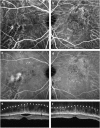Choroidal thickness in both eyes of patients with unilaterally active central serous chorioretinopathy
- PMID: 22020172
- PMCID: PMC3234484
- DOI: 10.1038/eye.2011.258
Choroidal thickness in both eyes of patients with unilaterally active central serous chorioretinopathy
Abstract
Objective: To assess the change in the choroidal thickness of the unaffected eyes in patients with unilateral central serous chorioretinopathy (CSC).
Methods: Thirty eyes with unilateral idiopathic CSC and 30 age-matched normal eyes were included in this study. Choroidal thickness was evaluated from images obtained by enhanced depth image optical coherence tomography. The choroidal thicknesses of the affected eyes, unaffected eyes, and normal eyes were analyzed. Choroidal vascular dilation and hyperpermeability on indocyanine green angiography (ICGA) were analyzed and correlated with the changes in choroidal thickness.
Results: The mean choroidal thicknesses of the affected eyes, unaffected fellow eyes, and normal individuals were 445.58±100.25, 378.35±117.44, and 266.80±55.45 μm, respectively. Compared with normal eyes, subfoveal choroidal thickness was increased significantly in the eyes with active CSC and in the unaffected fellow eyes (P<0.001 in both groups). The choroidal thickness was significantly greater in the eyes with active CSC than in the unaffected fellow eyes (P=0.003). ICGA revealed choroidal vascular hyperpermeability in 28 (93.3%) eyes with CSC and in 23 (73.3%) unaffected fellow eyes. Choroidal vascular dilation was detected in 21 (70.0%) eyes with CSC and in 18 (60.0%) unaffected fellow eyes.
Conclusion: Increased choroidal thickness in patients with unilateral CSC was noted not only in the affected eyes, but also in the unaffected fellow eyes. The results of this study suggest that CSC might be an essentially bilateral disorder.
Figures

References
-
- Spaide RF, Campeas L, Haas A, Yannuzzi LA, Fisher YL, Guyer DR, et al. Central serous chorioretinopathy in younger and older adults Ophthalmology 1996103(122070–2079.discussion 2079–2080. - PubMed
-
- Gass JD. Pathogenesis of disciform detachment of the neuro-epithelium. Am J Ophthalmol. 1967;63:12. - PubMed
-
- Marmor MF. New hypotheses on the pathogenesis and treatment of serous retinal detachment. Graefes Arch Clin Exp Ophthalmol. 1988;226 (6:548–552. - PubMed
-
- Spitznas M. Pathogenesis of central serous retinopathy: a new working hypothesis. Graefes Arch Clin Exp Ophthalmol. 1986;224 (4:321–324. - PubMed
-
- Guyer DR, Yannuzzi LA, Slakter JS, Sorenson JA, Ho A, Orlock D. Digital indocyanine green videoangiography of central serous chorioretinopathy. Arch Ophthalmol. 1994;112 (8:1057–1062. - PubMed
MeSH terms
LinkOut - more resources
Full Text Sources

